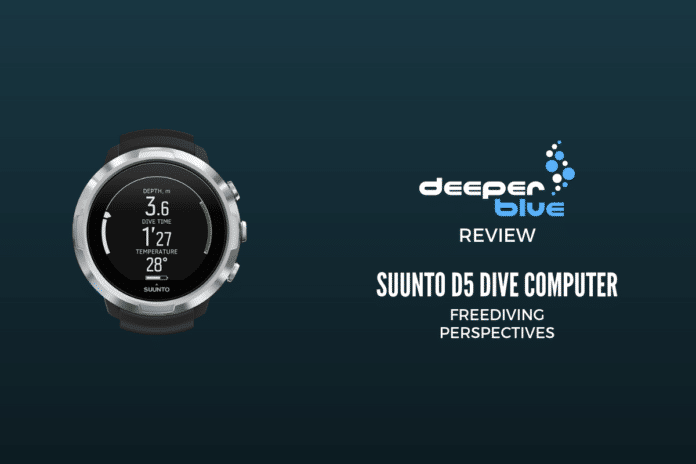We were lucky to be at the launch of the Suunto D5 whilst at the DEMA trade show in 2018, we’ve now got our hands on a unit from Suunto and put it through its paces both whilst Freediving and Scuba Diving. This review takes the computer on test dives whilst Freediving.
A month or so ago I was contacted by Suunto. They wanted to hear my ideas about FreeDiving Watches. “Oh boy!” I thought. “They’re in for it now.” I was annoyed by crude displays, weird abbreviations, and arcane, nested menus. I had a lot to say – and I had coffee!!
A week or so later I found myself conferring with Johanna from Suunto. She was gracious and genuinely interested as I prattled on about my dream FreeDiving watch.
“A display that’s not 20 years out-of-date” I demanded. “A compass; Easy to change screens that still show all the important stuff when you switch between them; Rechargeable; Silent alarms; Customizable… etc. etc.”
I was impressed when a week later the D5 was announced – embodying much of my wish-list, plus a few things I didn’t know I wanted. Naturally, I wrote Suunto and thanked them. You don’t often see customer service like that.
First Impressions and Getting Started
Let’s get this out of the way: The D5 is the coolest looking FreeDiving watch I’ve ever seen.
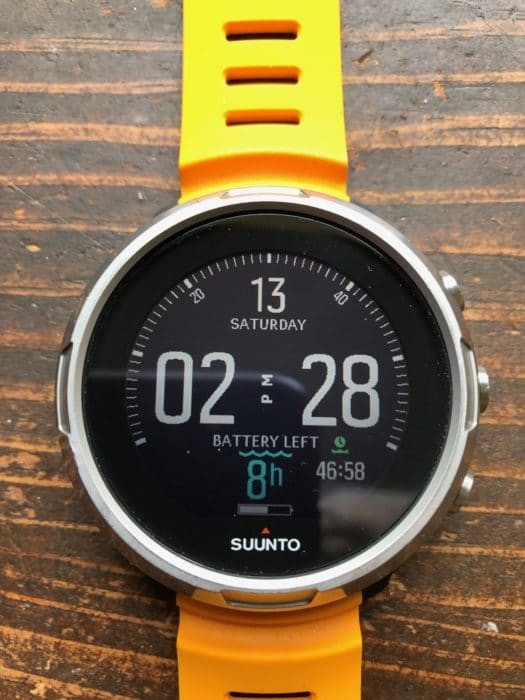
The only thing I needed to know to get the D5 up, running, and configured to my requirements was that holding down the center button for two seconds switches in and out of the setup screen. Once you know that, everything else is incredibly intuitive. Top and bottom buttons scroll, middle button (short press) selects. The menus are minimally nested and easy to understand – no weird abbreviations, easy to read, clear and straightforward.
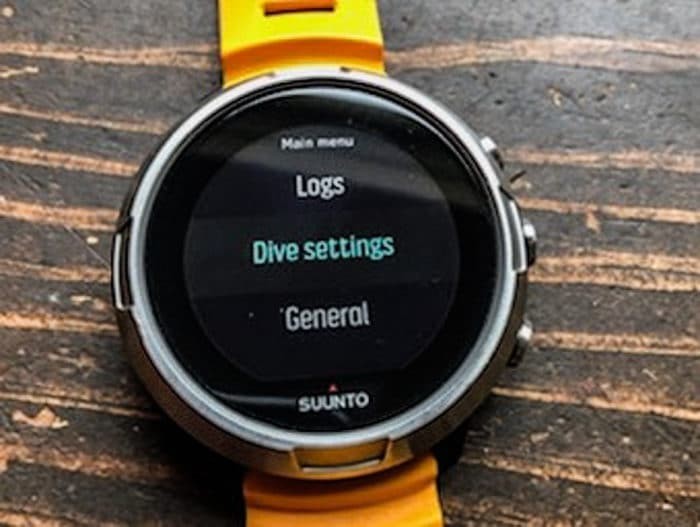
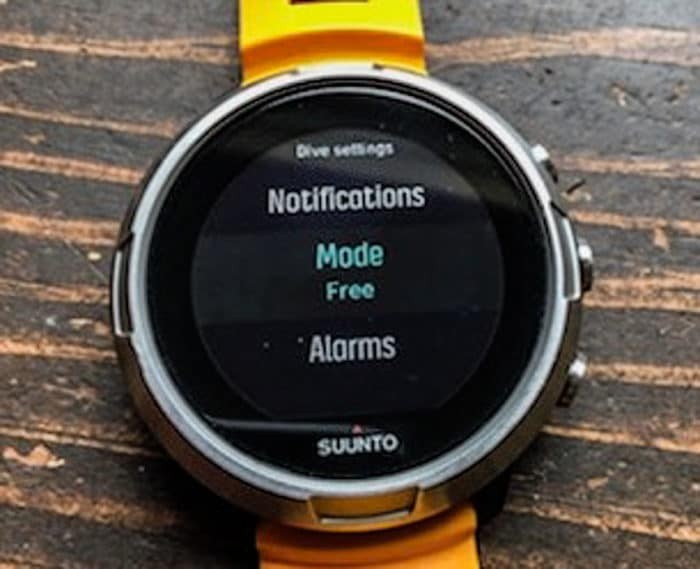
To test ease-of-use I took it to the pool before I read the manual or tried any settings. I decided to check out the depth alarm compared with my f.11 – which I’ve owned for years and use almost daily. Armed only with knowledge of the two-second middle button hold, it took me all of 15 seconds to set the depth alarm on the D5. By comparison, despite my familiarity with the f.11, it took me a full 10 minutes of incorrect button pushes and backing out of screens to sort out how to change its depth alarm.
I tried out the middle-button-is-all-you-need-to-know hypothesis on my coworker and erstwhile diving compadre, Jason. When he showed up for work I handed him the D5 and told him; “Hold the middle button down for two seconds and all is coming.”. Within three minutes he had it figured out – no questions – no manual – no instruction.
That said, the Suunto site is rife with instructional videos. Like all such videos, they make it look easy. The difference here is that it really is that easy. Likewise the manual, which is clear, concise and easy-to-use – with embedded links to the various sections.
A Brief Overview of Dive Mode Screens and Options
When FreeDive mode is turned on in settings a single middle button push navigates through four available screens: Time (normal surface clock), then three Dive Mode screens – Time, Depth, and Compass. Each screen displays depth and time – what changes is the indicator around the periphery, which graphically displays elapsed surface or dive time, depth, or compass heading. The backlight, when set, is always on when the watch is wet. (For the normal clock face it is turned on for 5 seconds by pushing any button – I’d like to see this last as an option for Dive Mode as well.)
Each of the three dive screens also allows you to cycle through secondary readouts using the bottom button. These appear below the current (or last if on the surface) elapsed dive time and may be customized using the Suunto DM5 software.
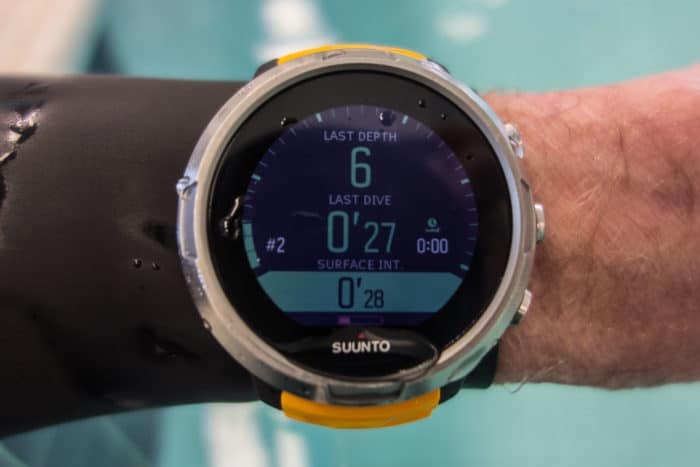
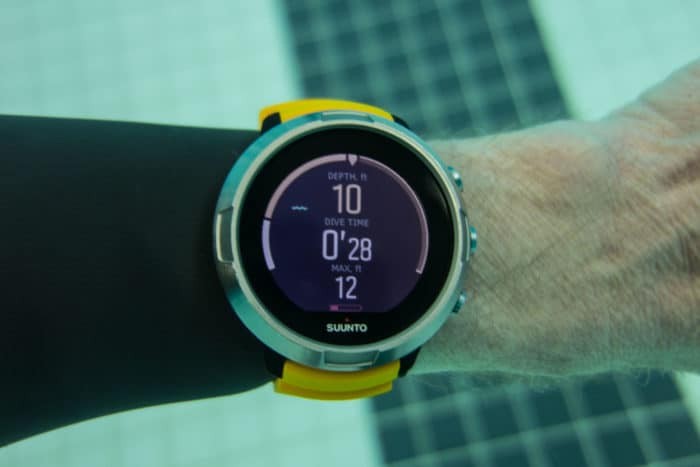
Notifications, Alerts, and Logs
Notifications are the depth alarms in the D5. There are five of them and they are accessed through settings. Alarms are for do-not-exceed situations and are continuously activated until you ascend above the set depth or press a button. Notifications are triggered briefly as you descend past a set depth.
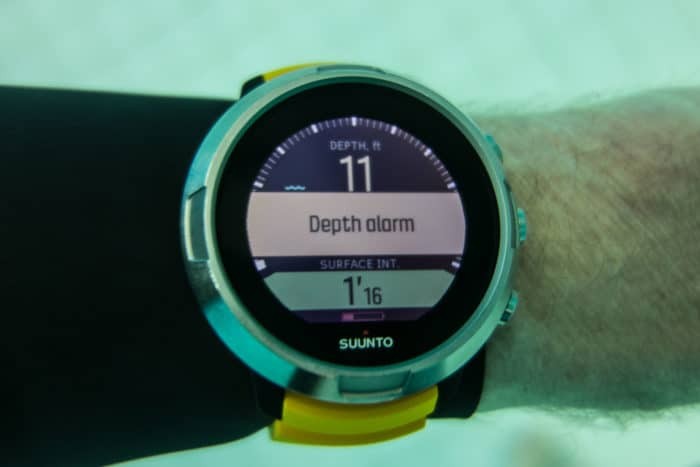
There are four signal choices for both alarms and notifications. They are a two-tone beep, a vibration, both, or off. The audio alarm is pretty much the same as any other gauge I’ve used and is generally audible in quiet conditions (no boat noises). The haptic (aka – vibration) alarm works well with a thin suit once you are attuned to it.
Dive logs are easy to access, and graph on the watch display with just a couple button clicks.
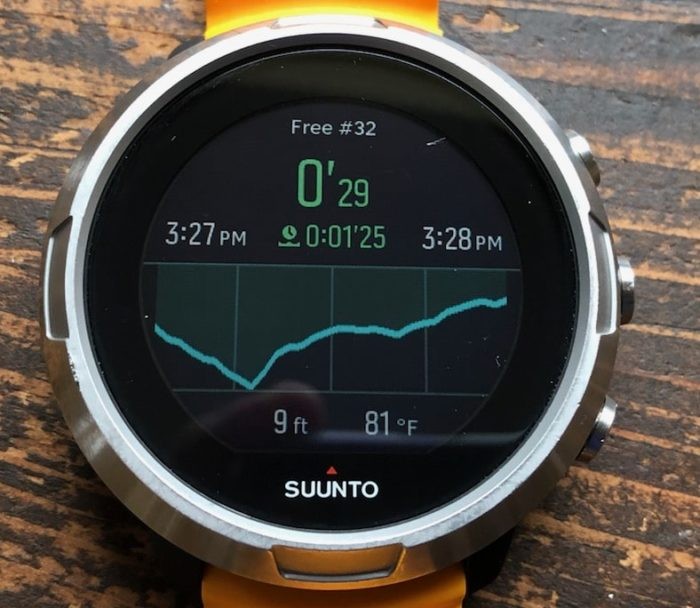
Battery Life, and Connectivity
I ran the D5 down until it started giving me warnings. With five hours of diving, this took a full week. With the backlight turned off it would be longer. I’d say battery life is not a problem. I did not track the time to a full charge, but it is very fast.
Connecting the D5 via Bluetooth to your smartphone is easy once you download the app. (How to videos are available on the Suunto site, but it’s so intuitive I did not need them) Likewise, connecting to your computer using the included magnetic USB cable. The DM5 software and phone app are both free to download. The phone app is a social media tool. The DM5 software is helpful for dive analysis and for customizing the dive mode watch faces. Like the watch itself, they are both extremely intuitive and easy-to-use.
Final Thoughts
This review is intended as a user’s overview of the general functionality and quality of the Suunto D5, specifically as it relates to FreeDiving. If you would like more precise information – be sure and check out the D5 Support Site.
Reviewing the D5 strictly from a FreeDiving perspective is a little unfair. At $849 -$899us it is pricey for a FreeDiving gauge. But if you take into account it’s mixed gas and scuba functionality, and the competition in that market, it’s quite reasonable.
I approached the D5 with high expectations, all but a few of which were exceeded. Among those is that a watch at this price point should replace my current watch as a training tool – an area where the D5 falls short for the following reasons:
- Activation Depth – This is hard-coded at 4ft/1.2m, which makes the watch useless for pool training. I’d like to see a settable option for 2ft/.6m (I set my current watch at 2ft/.6m for pool work – then back to 4ft/1.2m for open water.).
- Depth notifications – These work only on the way down. They do not activate during ascent – a useful feature for depth work.
- Sample Rate for Logs – Set at one second. It would be nice to be able to set higher, say .5 sec, for depth training (counting fin/arm strokes).
Because I train all winter in a pool, activation depth is a big deal for me. The others are low enough priorities that they would not influence my outrageous-expenditure-rationalization-process.
Key Features
- Rechargeable Lithium-Ion Battery (USB)
- Updatable Software
- 100m/328ft Water Resistant
- Air/Nitrox, Freedive, Digital Compass, and Gauge Modes
- Wireless Tank Pressure (up to 2 pods)
- Wireless Bluetooth Mobile Connection to Suunto App
- Exchangeable Silicone and Leisure Straps
- Vibration Alarms
Technical Specs
- Stainless Steel Bezel
- Mineral Crystal Glass
- Reinforced Composite Case
- 320 x 300 Display Resolution
- Weight: 90g/ 3.17oz
- 6-12 hour Dive Time Battery Life/ 6 Days in Time Mode
- Up to 3 Gases
- Gas Max pO2 of 1.6
- Lifetime Dive History
- 200h or 400 dive Logbook Memory
- Suunto Fused™ RGBM 2 Decompression Model
Price (MRRP)
- D5 Dive Computer: $899.95 USD / €649 EUR
- SUUNTO Tank Pod: $439.95 USD / €299 EUR

